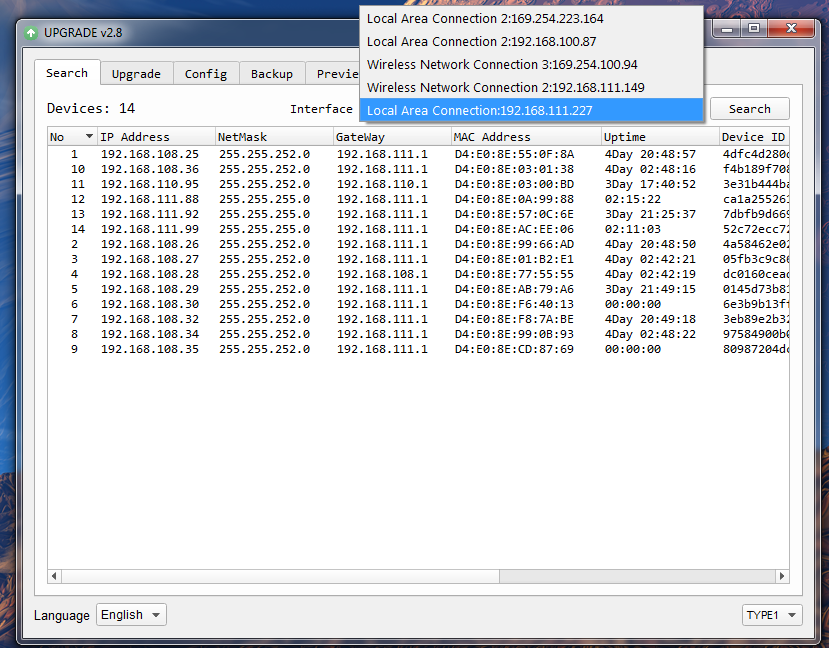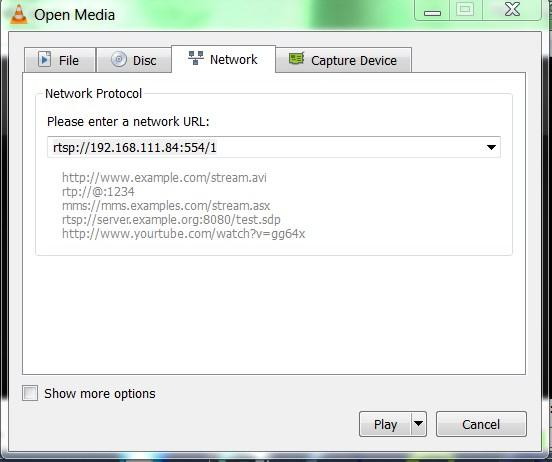How do I set the SMTAV camera to be on my network?
How do I set up my SMTAV camera to be “on my network”?
-
The first thing you are going to want to do to get your camera up and streaming on your network is to connect your camera to power, to an active network port on your network and finally to power the camera on.
-
Next, go online and download the Upgrade tool (IP address setting tool), from the SMTAV Download Page. This is available for MAC(Mac Upgrade Tool v2.7) or Windows machines(Win Upgrade Tool v2.7). The program downloads as a ZIP file, so it needs to be un-zipped on your machine before you can run it.
-
The program uses mDNS for discovery, so if you are using a switch that does not support mDNS, this program may not find your cameras. If this happens, look at the extras section at the end of this guide.
-
Once you run the program, you should be able to change the “interface” option in the upper right of the search tab. This is letting you select the different NIC (network) ports on your computer. The program does always have some multicast addresses in the interface options as well. If you don’t know which option is your connection to the camera, please take a look at the extras section at the end of this guide to find your IP range, and then select the option that is that range.

-
The next thing to do is change your camera's IP address to be in the same range as your network. The camera comes with a default static IP address of 192.168.100.88. You will need to update that to be in the same range as your network. This should be the first (3) sets of digits from the interface you are using the find the cameras. Our network is set up to be 192.168.111.xxx. We also have a different Subnet setup with the 192.168.108.xxx so both IP schemes show up with all our cameras on the network. NOTE: if you need to find the IP range of your network, you can do so by following the guide in the extras section at the end of this document.
-
The camera has numerous IR shortcuts built in to help with this process of finding your camera's IP address and getting it on the network.
Star (*) then Pound (#) then (4) – will show you the current IP configuration across the video output. So you can have the HDMI hooked up to a monitor, it will tell you the IP address the camera currently has.
Star (*) then Pound (#) then (Manual) – This will reset your IP configuration or the camera back its static setting at its static IP address of 192.168.100.88 (PTZ cams) or 192.168.100.99 (Zcams). The camera will reboot after receiving this command.
-
Once you know your IP range you can right-click on the camera you wish to change the IP address for and click “config”.

You should now be able to set your cameras IP address to one in the range of your network. You should be able to leave the subnet mask alone unless there is a reason for you to change it. The Gateway should be the same as the IP address you used, but .1 instead of the last set of digits in your IP address. So, in my example above, 192.168.111.92 IP address should have 192.168.111.1 as the gateway.
Please note: in more complex network environments you may have to request a “STATIC IP” from the IT department to prevent any possible complications on your network in addition to the appropriate Network Mask, Default Gateway and First DNS for that Static IP
-
Now that you have set the Static IP address of your SMTAV camera, you should be able to pull up the IP interface by typing the IP address into a browser. You will be prompted for a Username and Password, both are “admin” by default.
- You can preview the video on the IP interface. You can also adjust most of the network video source and camera settings from the IP interface.
- You can test your camera feed using the Upgrade 2.8 tool by right-clicking on your cameras IP address in the search and choose “Preview”. You should be able to then click connect, and get a video feed and control of the camera over the network.
- You should now be able to receive an RTSP stream from your camera. You can test the RTSP stream in VLC media player. Once you install VLC and launch the program you should be able to go to the “Media” drop-down menu and then select “Open Network Stream”. In the network URL, you should enter “rtsp://<ip-address>:554/1”. In the example below, for a PTZOptics camera with the static IP address of 192.168.111.84, the RTSP stream would be accessed by entering rtsp://192.168.111.84:554/1. The “554” part is the port number used by the cameras, and the “1” is the stream number. (There are two RTSP network streams available; one for HD content “1” and one for SD content “2”)

EXTRAS
1. Discovering your Network IP range (WINDOWS).
PLEASE NOTE: Changing your IP address without talking to your network admin could lead to conflicts with your network. If you change your address to one that is already in use it will cause communication problems.
If you need to discover the IP address range of your network you can do so by using command prompt for Windows or Terminal for Macs.
To do this on a PC, you would type “CMD” into your search bar in the Windows menu. You should see a black box pop up with the ability to type in the box.
If you type “ipconfig” and hit “Enter” on your keyboard you will see a bunch of information pop up in your command prompt.
This information is all the various ways your computer has to connect to a network. There is usually a Local area connection one, and then a Wireless one, but sometimes Bluetooth or other ethernet ones. You should be using the ethernet one, or local area connection. In my example below, I only have a wireless network connection, and a wired one and they both have the same IP scheme.
The “Ethernet adapter local area connection” is the one I want to use the IP scheme from because that is the wired
connection to my computer and since the camera is only wired into my network, that has to be where my camera is.
When you see “IPV4 Address” that is your computers IP address on your current network. So you would use the first 3 sets of numbers from this as your IP range
2. Discovering your Network IP range (MAC)
If you need to find the IP range of your MAC computer, you would first open a new finder window and then go to Applications, and then Utilities. You should see the program “Terminal” in that menu, select that program.
Now, you would type in “ipconfig getifaddr en0” Once you type this string and click “Enter” on your keyboard you will receive back an IP address.
So the IP range of my network, according to my MAC is 192.168.111.xxx, you can use this to figure out the IP range in which your camera needs to be set.
3. What do I do if the Upgrade tool cannot find my cameras?
Since the Upgrade tools uses mDNS for discovery, if that is not set up or available on the network, the tool is going to have issues finding the cameras.
There are only (2) ways around this.
-
You can try and use DHCP mode. If the router in the network has been set up for DHCP you can use the IR shortcut listed above to set the camera to be in DHCP mode, and then use the shortcut to see the current IP address, and you should be good.
-
The other option would be to set up your computers static IP address to be within range of the default IP address on the camera. The camera ships with an IP address of 192.168.100.88 (ptz cam) or 192.168.100.99 (zcam). Using the IR shortcuts listed previously in this guide, you can reset the camera back to default, then follow the linked guides to set the static IP of your computer to be in the same range (192.168.100.89 is a good one). You can then get into your camera by typing the IP address into a browser and going to the network tab. Here, you can set whatever IP address you wish for the camera, click apply, and then go to the system tab and reboot. Now, be sure to go back to your network settings and change the IP address of your computer back to what it was previously.
Setting static IP address for a PC in windows. -
https://kb.netgear.com/27476/How-to-set-a-static-IP-address-in-Windows
Setting a Static IP address for a MAC -



have a SMTAV camera, 20x, tried using “# + 4” nothing happens. Am I missing something? I need this in DHCP so I can see it on our closed network.
hello
I purchased a Live Solution Kit, Three 30X Optical Zoom NDI Camera and One Joystick controller and One PoE Switch.
Camera IP: 192.168.100.88 I want to know how to change each IP.
can i use ip ptz cam with GStreamer? successful with it with our exisitng cctv ip cams. it solve latency problems we encountered when using with OBS
Hi. Can I record onboard on memory stick. If so then how?
Thanks for the setup instructions. Very helpful.